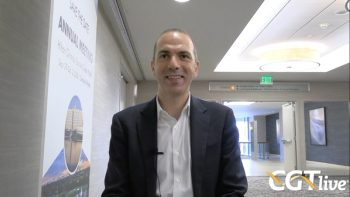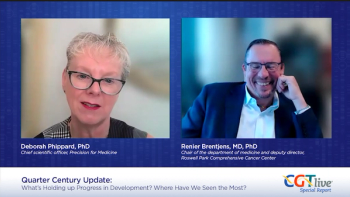
Elotuzumab/Lenalidomide Maintenance Deepens Responses After Transplant in Myeloma
Maintenance therapy with elotuzumab (Empliciti) and lenalidomide (Revlimid) after autologous stem cell transplant improves the quality of response achieved with induction therapy in patients with multiple myeloma.
Sheeba Thomas, MD
Maintenance therapy with elotuzumab (Empliciti) and lenalidomide (Revlimid) after autologous stem cell transplant (ASCT) improves the quality of response achieved with induction therapy in patients with multiple myeloma (MM).
In results from a phase II study presented at the 2017 ASH Annual Meeting, 25 of 68 patients treated with the combination as maintenance therapy experienced improvements in response, and 20% of patients converted to either a complete response (CR) or stringent CR (sCR), reported lead author Sheeba Thomas, MD, professor, Department of Lymphoma/Myeloma, MD Anderson Cancer Center, Houston.1
“This improvement in response is no doubt the combined effect of stem cell transplant together with lenalidomide-elotuzumab,” she said. “The number of patients achieving CR may in fact be underestimated due to elotuzumab interference with electrophoretic measurements. Nineteen of 33 patients not achieving CR had GK paraproteins, and 17 of the 19 were in [very good partial response] VGPR.”
At a median follow-up of 23 months, median progression-free survival (PFS) and median overall survival (OS) have not been reached. The 2-year estimated PFS was 88%.
Landmark phase III trials found significant improvements in PFS with maintenance lenalidomide compared with placebo following ASCT.2,3 However, only the CALGB 100104 trial showed an improvement in OS “perhaps due to longer length of therapy with lenalidomide,” said Thomas.
Elotuzumab is a humanized IgG 1 monoclonal antibody targeted against SLAMF7. It is thought to have a dual mechanism of action—by binding to SLAMF7, it directly activates natural killer cells but not myeloma cells, and by activating natural killer cells via CD16, it enables selective killing of myeloma cells via antibody-dependent cellular cytotoxicity.
Updated results from the ELOQUENT-2 phase III trial of lenalidomide plus dexamethasone with or without elotuzumab showed that the the addition of elotuzumab as maintenance therapy sustained improvement in PFS in the relapsed/refractory setting that persisted through 4 years of follow-up.4
In the study presented here, the combination of elotuzumab and lenalidomide as maintenance therapy post-myeloablative ASCT was evaluated in patients treated with ≤2 lines of systemic therapy prior to ASCT. Eligible patients underwent ASCT within 18 months of starting induction therapy for newly diagnosed MM and were able to start therapy within 210 days of ASCT. Planned enrollment was 100 patients.
The first 28 patients were treated with 10 mg elotuzumab weekly for cycles 1 and 2, bimonthly for cycles 3 through 6, and 20 mg/kg monthly from cycle 7 forward. The study was amended to 20 mg/kg elotuzumab monthly during cycles 3 through 6 (n = 40). This change was primarily for patient convenience, according to Thomas.
Patients younger than 75 years were instructed to take 28 mg dexamethasone 3 to 24 hours prior to infusion for cycles 1 and 2. This dosage was reduced to 8 mg for patients ≥75 years in an effort to optimize tolerability. All patients received 4 to 10 mg of dexamethasone intravenously immediately prior to each infusion.
Lenalidomide was administered at 10 mg daily for cycles 1 through 3 and could be increased to 15 mg daily from cycle 4 forward in the absence of significant cytopenias and non-hematologic toxicity at the discretion of the treating physician.
The median age of the 68 patients accrued thus far was 68 years. Seventy-one percent had 1 line of induction therapy prior to ASCT and 29% had 2 lines. All but 2 patients received a 3-drug induction regimen as part of initial therapy, the most common (72%) being a proteasome inhibitor plus lenalidomide and dexamethasone. The median time from ASCT to the start of trial therapy was 158 days.
Prior to induction therapy, 55% of patients were International Staging System (ISS) stage I, 32% were stage II, and 13% were stage III. By the revised ISS, 47% were stage I and 53% were stage II. Ten patients could not be assessed by revised ISS stage.
High-risk cytogenetic features included del 17p in 10% and t(4;14) in 7% of patients. A total of 21 patients (31%) were assessed as having high-risk cytogenetics by International Myeloma Working Group criteria.
Twenty-five (36%) patients had an improvement in the quality of response from study entry, including 17% who improved their response from PR to CR or sCR and 20% who improved from ≤CR to CR or sCR. For patients who upgraded their response, the median number of cycles to best response was 3.5.
Thirteen patients in CR were tested for minimum residual disease (MRD). Ten were MRD-negative at study entry and 3 converted from VGPR to MRD-negative. In total, 75% of patients were in ≥VGPR at time of study entry.
“This has improved to 91% based on best response estimates on study, including 51% who have achieved CR or sCR,” Thomas said. Investigators observed no difference in PFS according to cytogenetic risk. Six patients progressed, 3 with high-risk features and 3 with standard-risk features. One patient with high-risk features died while in VGPR.
Three patients have died, 2 from progressive disease while on salvage therapy and a third from acute encephalopathy with refractory status epilepticus while in VGPR.
Seventy-one percent of patients had any-grade anemia, 69% had neutropenia, and 68% had thrombocytopenia. Grade ≥3 anemia, neutropenia, and thrombocytopenia occurred in 6%, 31%, and 7% of patients, respectively. The rate of grade ≥3 febrile neutropenia was 4%. Fatigue (76%) was the most common non-hematologic adverse event (AE), followed by myalgias (71%), diarrhea (69%), respiratory infections (57%), nausea/vomiting (57%), and dizziness (56%).
Forty-four percent of patients required dose reductions of lenalidomide. Thomas said most patients are currently dosed at 10 mg on days 1 through 21 of the 28-day cycle due to intolerability.
Four patients developed secondary primary malignancies—intraepidermal adenocarcinoma of the neck, mucinous appendiceal neoplasm, renal cell carcinoma, and therapy-related myelodysplastic syndrome. The first 3 were managed with curative resection and the patinets remain free of disease related to their second primary malignancy. Two patients remain on study.
References
- Thomas SK, Shah JJ, Weber DM, et al. Preliminary results of a phase II study of lenalidomide-elotuzumab as maintenance therapy post-autologous stem cell transplant in patients with multiple myeloma. Presented at: Presented at: American Society of Hematology 59th Annual meeting; December 9-12, 2017; Atlanta, GA. Abstract 840.
- McCarthy PL, Ozwar K, Hofmeister CC, et al. Lenalidomide after stem-cell transplantation for multiple myeloma. N Engl J Med. 2012;366:1770-81.
- Attal M, Lauwers-Cances V, MaritG, et al. Lenalidomide maintenance after stem-cell transplantation for multiple myeloma. N Engl J Med. 2012;366:1782-91.
- Dimopoulos MA, Lonial S, White D, et al. Elotuzumab plus lenalidomide/dexamethasone for relapsed or refractory multiple myeloma: ELOQUENT-2 follow-up and post-hoc analyses on progression-free survival and tumour growth. Br J Haematol. 2017;178:896-905.
Newsletter
Stay at the forefront of cutting-edge science with CGT—your direct line to expert insights, breakthrough data, and real-time coverage of the latest advancements in cell and gene therapy.










































